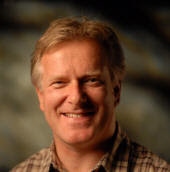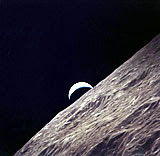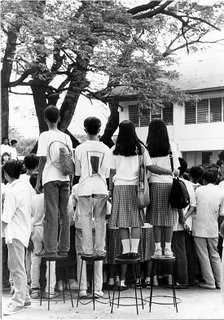Apollo Moon Documentary Bears Witness
for a Creator
By Mark Ellis, Senior Correspondent, ASSIST News Service
LONDON (ANS) -- A film documenting the Apollo moon project using rare footage from NASA contains numerous spiritual references pointing to the existence of God.
“In the Shadow of the Moon” opened September 7th to positive reviews, including a “Critic’s Choice” designation by the L.A. Times and an award at the 2007 Sundance Film Festival. “It’s a film about the experience of going to the moon told by the people who went – in their own words,” says David Sington, who directed the film. One of Sington’s associates got acquainted with Dave Scott, commander of Apollo 15 and the first man to drive on the moon. “They wanted to organize a reunion of moonwalkers,” Sington says. “That grew into an idea of doing a reunion on film.”
“It’s a film about the experience of going to the moon told by the people who went – in their own words,” says David Sington, who directed the film. One of Sington’s associates got acquainted with Dave Scott, commander of Apollo 15 and the first man to drive on the moon. “They wanted to organize a reunion of moonwalkers,” Sington says. “That grew into an idea of doing a reunion on film.”
Producer Duncan Copp proposed the idea of a documentary to Sington, who said it took him only 15 milliseconds to decide on the project.
With astronaut Scott’s help, the film team managed to assemble crewmembers from every Apollo mission that flew to the moon and interview them directly on camera. The 10 astronauts – now in their seventies – come across as surprisingly reflective and human. Many spoke of the profound impression they gained from walking on the lunar surface and gazing back at a marble-sized planet Earth. In addition to the interviews, producers Duncan Copp and Chris Riley spent weeks at NASA’s film library in Houston pouring through cans of film – many of which had not be opened for 30 years. They uncovered a veritable treasure trove, which the filmmakers re-mastered to produce a film of striking visual clarity.
In addition to the interviews, producers Duncan Copp and Chris Riley spent weeks at NASA’s film library in Houston pouring through cans of film – many of which had not be opened for 30 years. They uncovered a veritable treasure trove, which the filmmakers re-mastered to produce a film of striking visual clarity.
Apollo 16 astronaut Charlie Duke, the 10th man to walk on the moon, makes an explicit declaration of his faith in Jesus Christ on camera. His spiritual revelation came after his retirement from the space program in the mid-seventies. Mounting pressures in business and his personal life caused Duke to grapple with life’s ultimate questions. In 1978, after he attended a Bible Study about Middle East prophecy, Duke realized Jesus “really is the Son of God.”
Astronauts Edgar Mitchell and Gene Cernan described profound spiritual experiences, but not within a specific Christian context. Cernan discovered the universe seemed to have purpose behind it, that there must be a Creator who stands above the religions of mankind. “Edgar Mitchell’s experience profoundly changed and shaped his whole life,” notes director Sington. “He had a moment of epiphany – suddenly grasping who he is in relation to the universe. This was accompanied by a sense of ecstasy, almost like people who have had visions of the Virgin Mary.”
“Edgar Mitchell’s experience profoundly changed and shaped his whole life,” notes director Sington. “He had a moment of epiphany – suddenly grasping who he is in relation to the universe. This was accompanied by a sense of ecstasy, almost like people who have had visions of the Virgin Mary.”
“He’s striving to understand his spiritual epiphany in scientific terms,” Sington adds. “He’s dedicated his life to understanding human sub consciousness and to finding the ‘Great Mind’ of the universe.”
Unfortunately, the man who had the closest encounter with Jesus Christ on the moon does not appear in the film. “Sadly enough, the person who had the most profound spiritual experience was Jim Irwin, who died,” says Sington. “He really had a ‘road to Damascus’ experience on the moon.” Irwin died in 1991 from a heart attack. In Irwin’s book, “To Rule the Night,”he described his view of Earth from the moon, which looked like “a beautiful, fragile Christmas tree ornament hanging against the blackness of space.” The beauty of the mountains of the moon moved Irwin, and he said he felt the presence of God during his moonwalk. “The moon has a powerful force; it seems to affect the feelings and the behavior of everybody. I cannot imagine a holier place,” he wrote.
In Irwin’s book, “To Rule the Night,”he described his view of Earth from the moon, which looked like “a beautiful, fragile Christmas tree ornament hanging against the blackness of space.” The beauty of the mountains of the moon moved Irwin, and he said he felt the presence of God during his moonwalk. “The moon has a powerful force; it seems to affect the feelings and the behavior of everybody. I cannot imagine a holier place,” he wrote.
Some would consider the trip to the moon as one of man’s greatest accomplishments, but Irwin had a different perspective. Afterward, he frequently said, “I believe Jesus Christ walking on the earth is more important than man walking on the moon.”
Irwin retired from NASA in 1972 and founded High Flight, a Christian ministry. He traveled frequently and spoke to groups about the ways his experiences in space increased his awareness of the presence of God.
“My view is that all of them were profoundly affected by the experience of leaving the Earth and seeing the Earth in its true context,” Sington says. “The photographs they took were a revelation to everybody that helped shape the way we think of ourselves on the Earth,” he notes.
Some might consider the awareness gained by the men who walked on the moon as the ultimate mountaintop experience. “They had the experience firsthand, which is a different order of experience.”
Many of the astronauts saw the universe as fundamentally sterile, a seemingly endless dead expanse. By contrast, Earth appeared to be a very special oasis -- almost Edenic, and yet fragile. For some, this increased their environmental awareness, as well as a sense of gratitude about living on planet Earth. “They feel life in a slightly stronger way than the rest of us,” Sington observes.
Apollo 11 astronaut Mike Collins, the most affable of the astronauts to appear on camera, described a moment of exaltation in his orbiter as he realized he was alive in a place where there was no other life.
One of director Sington’s disappointments was his inability to persuade Neil Armstrong to abandon his notoriously reclusive nature and appear in the film. “I think I understand why he doesn’t want to talk about being on the moon,” Sington says. “He sees himself as a messenger, not the message, a representative of all of us. He takes that very seriously.”
Sington came away from the film more inclined to accept a spiritual dimension to life. It also made him a bit more optimistic about the future, based on the Apollo project’s demonstration that human societies – particularly democracies -- are capable of large-scale collective efforts apart from waging war.
“In some sense perceiving reality is spirituality,” Sington concludes. “Religion and Christianity says we’re missing what’s really important,” he says. “When you see things as they really are you get a more profound spiritual sense.”
“In the Shadow of the Moon” is rated PG for mild language, brief violent images, and incidental smoking.
[ASSIST News Service, PO Box 609, Lake Forest, CA 92609-0609 USA; Visit ANS website at: http://www.assistnews.net/ -- E-mail: assistnews@aol.com]
P.S. You might also want to play this Flash movie "God of Wonders" by Tim Gibson. My personal preference is still the traditional hymns but Gibson's movie is quite appropriate after you have read Mark Ellis' article posted above.
Thursday, October 18, 2007
Photojournalism (32): Photo essays and themes
| Update as of September 18, 2023:
If you’re a high school or grade school student in the Philippines who’s joining the photojournalism contest in the division, regional, or national press conference, I’m offering two free resources to you : A. 900-plus interactive exercises on English grammar, vocabulary, reading comprehension, verbal analogy, etc (with around 200 megabytes total file size). The exercises have time limit and automatic scoring, with an average of 10 items per exercise. Examples of these interactive exercises are: Common English grammar errors: Exercise 01 (nouns - confusions of number); Phrasal Verbs: Expressions with Go; English Placement Test (45 items). B. 200-plus resources (JPG, PDF, MP4, etc.) on photography and photojournalism, with 600-plus megabytes total file size. For some examples of these resources, surf to the “Free photography e-books, cheat sheets” page. For the download links and more information about how to use the interactive exercises, please surf to my “Better English resources and exercises” blog. Please inform your journalism teacher/schoolpaper adviser or your parents about these resources before downloading them. If you have any question about downloading or using these free resources, please email me (after informing your journalism teacher/schoolpaper adviser or your parents). I’ll be able to reply to you within two to three days; if you don’t see my reply in your Inbox, check your Spam folder. Or, you can text me. Also, if you win in the photojournalism contest at whatever level (district, division, regional, or national), you can send me your prizewinning pictures, and I will feature them in a blog post. Atty. Gerry T. Galacio gtgalacio@yahoo.com 0927-798-3138 |
| Examples of photo essays: Trouble Shared (Brenda Ann Kennelly/ New York Times/Lens); A Country Doctor (W. Eugene Smith/Magnum for Life); A Young Father’s Balancing Act (Benjamin Norman/The New York Times); New York City Coffeehouse (Dima Gavrysh/Lens); Where Beauty Softens Your Grief (Gianni Cipriano/ICP); Gun Nation (Zed Nelson); What the World Eats (Time); Last Supper (2004; Celia A. Shapiro/Mother Jones); The Bitter Sweet Pill – GMB Akash; Happy Horsemeat (Alex Soth) Unusual photo essays: February Assignment: Photographing Pictures in Reflection; Magic in the Nearly Forgotten Mailbox; Andrew Moore Detroit; Dulce Pinzon (The real story of the Superheroes; A Photo Fright Most Viral; Jump Book – Phillippe Halsman |
Limiting the topic for your photo essay
We’re all familiar with writing essays or themes for our English or Filipino subjects. What do teachers emphasize before you write out that essay? Limit your topic. The same advice holds true for a photo essay:
1. Decide first what your general topic or your subject will be - people, places, events, programs, universal truths, etc.
2. After deciding on your general topic, the next step is to come up with a limited topic. People- concentrate on one person or a specific group; places - your school, your community; activities - enrollment, graduation, summer class; universal truths - love between a mother and child, pizza’s the best thing ever to happen in history...
Using themes for your photo essay
A photo essay can make use of certain themes. Various pictures taken in different places, different times of the day, can be grouped together to illustrate a certain theme, whether serious or lighthearted, significant or trivial, like the pictures below which show students using chairs in creative ways other than sitting on them.


 Speaking of themes ... if you have seen the Oscar best picture for l989, “The Last Emperor” directed by Bernardo Bertolucci, then you probably know that the recurring thematic device used all through the movie was the opening and closing of all kinds of doors or entrances.
Speaking of themes ... if you have seen the Oscar best picture for l989, “The Last Emperor” directed by Bernardo Bertolucci, then you probably know that the recurring thematic device used all through the movie was the opening and closing of all kinds of doors or entrances.| Relevant article: “Week Five_The Photo Essay” from CUNY Graduate School of Journalism (topics include kinds of shots like signature shot, process, interaction, clincher, etc., and how to structure your narrative) |
In whatever way you develop your photo essay, thematically or chronologically (we’ll discuss this next time), you have to vary your shots, your viewpoints. Use close-ups, medium shots, full shots and long shots. You have to employ a variety of lenses. You have to shoot at different times of the day; use different viewpoints (eye level, low and high). You also have to shoot using both horizontal and vertical formats.
Kinds of pictures in a photo essay
In a written essay, you have the introduction, the body, and the ending or conclusion. In a photo essay, you would need different kinds of pictures - (1) establishing shots to show your viewers the setting or context of your subject; (2) major actions, stages or developments, to illustrate your theme or subject: (3) minor pictures which can serve as transitions; and, (4) pictures that will effectively close out your photo essay.
In a written essay, you always try to end it with a punch, with a line or expression that gives it a sense of completeness, a sense that nothing has been left hanging. With a photo essay, you try to end it with a picture that also brings a sense of completeness. In literature, we call this sense of completeness as “catharsis” which means a purgation of the negative emotions created within the reader. In Hollywood film making and scriptwriting, it’s called “closure” which means that the ending must provide a sense of completeness, a sense that everything has been resolved satisfactorily.
National Geographic Live! - Alison Wright: Portraits of the Human Spirit: After confronting her own mortality in a near-fatal bus crash, photographer Alison Wright dedicates her career to capturing the human spirit through her photographs and writing.
Subscribe to:
Posts (Atom)





